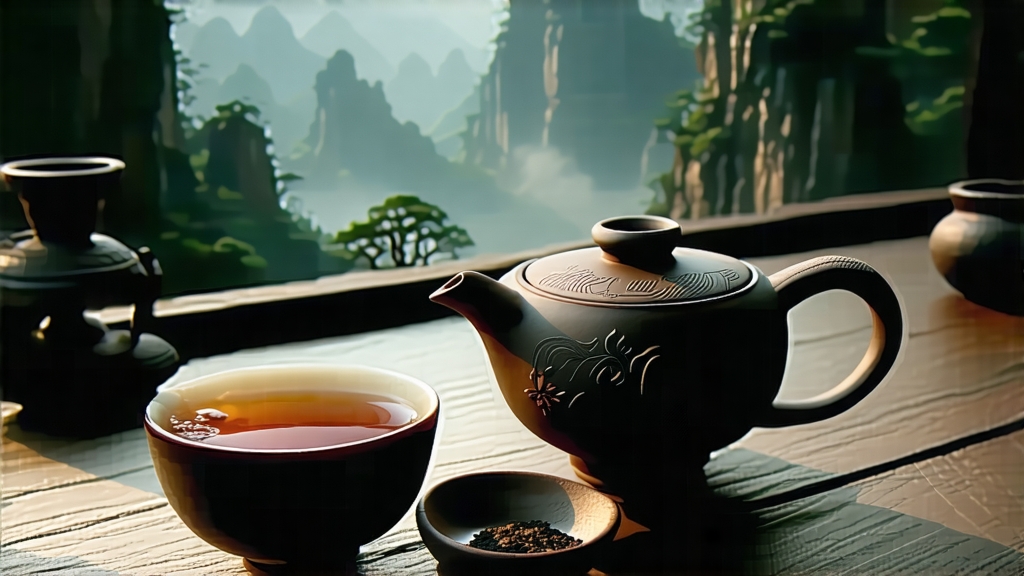
When Chinese tea lovers speak of “rock rhyme”—the mineral whisper that lingers on tongue and memory—they are almost always talking about Da Hong Pao, the great scarlet-robed oolong that grows from the vertical crevices of Wuyi Mountain in northern Fujian. To understand this tea is to step into a landscape where myth, geology, and craftsmanship converge, producing a liquor that has captivated emperors, poets, and twenty-first-century connoisseurs alike.
Legend places the birth of Da Hong Pao in the early Ming dynasty. A passing scholar, en route to the imperial civil-service examinations, collapsed from exhaustion on the steep trail that snakes through the Wuyi ravines. Monks from a nearby temple brewed leaves picked from six stately bushes clinging to the cliff opposite Nine-Dragon Cave; the restorative infusion revived the scholar, who went on to place first in the exams. In gratitude he draped his own imperial-red silk robe over the bushes, declaring them “Big Red Robe.” Whether apocryphal or not, the tale hints at the tea’s earliest reputation as medicine for both body and ambition.
Geologically, the Wuyi range is a 650-million-year-old rift valley whose purple-red sandstone and weathered tuff produce thin, mineral-rich soils. Frequent mists moderate sunlight, encouraging slow leaf growth and concentrating aromatic compounds. The micro-climate is so distinctive that Da Hong Pao is legally protected under China’s National Geographical Indication; only leaf picked within the 60-square-kilometre core scenic zone may claim the name “Zheng Yan” (true cliff) status.
Da Hong Pao is not a single cultivar but a stylistic family whose members share processing protocols rather than identical DNA. The historic “mother trees”—six ancient bushes still visible on Tianxin Rock—were last harvested in 2006, after which the government enacted a preservation ban. Today’s market relies on three sources: cuttings from those mother trees (called “pure pedigree”), high-genetic-similarity cultivars such as Bei Dou #1 and Que She, and skillful blends of compatible Wuyi bushes that recreate the classical flavor arc. Each path can yield superb tea, but the blender’s palate, not the cultivar alone, determines greatness.
Plucking begins in late April when the standard “open-face” leaf—three or four half-mature leaves with a pronounced central spine—is snipped at the second node. Experienced pickers look for a slight purpling at the leaf edge, an indicator of anthocyanin buildup that will later translate into orchid-like aromatics. The harvested shoots are transported in shallow bamboo baskets to prevent compression; oxidation begins within minutes of picking, so the clock is relentless.
Withering takes place first outdoors on water-reed mats, then indoors on raised bamboo trays. The outdoor phase lasts roughly 45 minutes, during which leaf temperature is kept below 28 °C; the goal is partial dehydration and the initiation of enzymatic oxidation. Masters judge readiness by the tell-tale “soft ear” phenomenon: when the leaf tip droops like a dog’s ear without snapping, the pile is carried inside. There, gentle warmth from charcoal-heated air softens the cell walls further, preparing the leaf for the most theatrical step—yaoqing, or “rocking green.”
Yaoqing is where Wuyi craftsmanship diverges from lowland oolong. The withered leaves are loaded into a 60 cm diameter bamboo drum mounted at 45°. The drum is rotated by hand every two minutes, allowing the leaves to tumble and bruise against one another. The master listens: a rustle like distant surf means bruising is still superficial; a muted thud signals cell rupture deep enough to release grassy volatiles. Over 45 minutes the leaf edges redden while veins remain green, achieving the classic “green heart with red border” hallmark of premium oolong.
Fixation follows immediately in gas-heated pans set to 220 °C. The objective is to halt oxidation at roughly 40 %—lower than Anxi Tie Guan Yin, higher than Taiwanese bao zhong. A rapid 7-minute toss-and-press motion denatures enzymes while locking in the rock-essence that later infuses the cup. From here the leaf is rolled, first mechanically then by hand, twisting the leaf into the tight, charcoal-black stripes that resemble miniature dragon tails.
Charcoal roasting is the soul of Da Hong Pao,